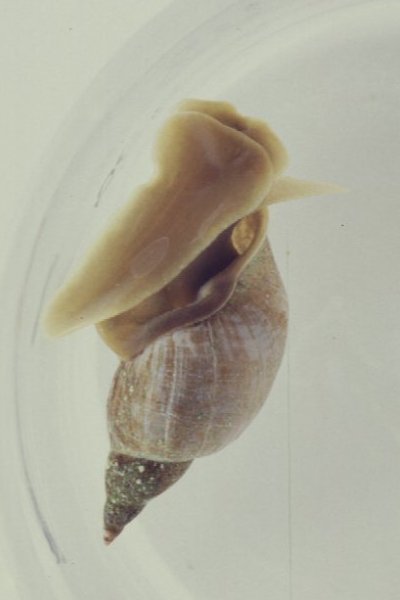| Gastropoda: Pulmonata |
||
| Mollusca | Basommatophora |
Pulmonata
└─► |
|||
None |
Mollusca |
|
Abbreviated Dendrogram
Gastropoda
├─Caenogastropoda
└─Heterobranchia
├─Opisthobranchia
│
└─Pulmonata
╞═Basommatophora
└─┬─Stylommatophora
└─┬─Systellommatophora
╘═Acteophila
|
Contents
Overview |

image © Chris Elliott
The Basommatophora are pulmonates with a single pair of tentacles; the eyes are located at the base of the tentacle.
This category includes more primitive members of the subclass than the land snails or Stylommatophora. The majority of Basommatophora species are found in freshwater, but there are also terrestrial and a few marine species. Some breathe air, others take oxygen from the water, and some do both. The freshwater genus Lymnaea includes species exhibiting all three respiratory habits. Chase (2002).
The shell varies widely from high-spired to flat and limpet-like, and the Planorbidae actually have planispiral shells. There are no shell-less species. Chase 2002).
The following classification is from Jeffery 2001. Superfamilies are in bold, families in normal font. The Lymnaeoidea, Planorbioidea, and Physoidea are listed as distinct superfamilies in Vaught 1989), but I have followed Jeffery (that being the more recent reference) in uniting them.
The Amphibolids are the only operculate pulmonates. They inhabit salt marshes near the sea, and are able to seal the shell with the operculum and so survive dry periods buried in mud. Macpherson & Gabriel 1962).
The Siphonariids, which inhabit marine intertidal environments, and are considered the most primitive forms. Siphonaria is one of the few pulmonates that possesses a veliger larva, indicating its marine habitat is not a secondary return to the sea, it also has a secondary gill. Barnes (1980).

The Lymnaeoidea include a large number of freshwater forms. Species like Lymnaea , Bulinus, and Physea come to the surface to obtain air. But some deep lake lymnaeids have abandoned air breathing and fill the mantle cavity with water. Secondary gills are found in Ancylids, which are freshwater limpets adapted to life in fast-flowing streams. They are also found in some Planorbids, which may also have secondary gill folds inside the mantle cavity. Barnes (1980).
page uploaded 20 December 2002
checked ATW040201
page by M. Alan Kazlev (Creative Commons License)
unless otherwise indicated by copyright notice, this material may be freely used if attribution is given